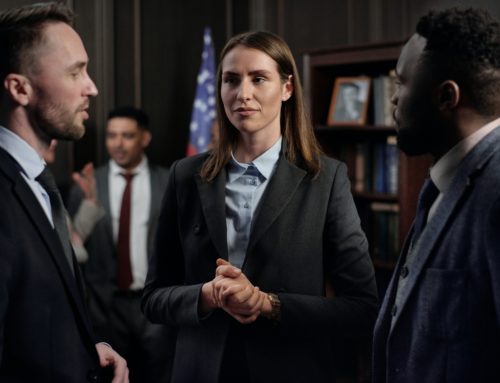In too deep? 7 questions to judge how involved to get in a piece of work
May 27, 2021
How involved should you get in work which is not your sole responsibility? It sounds like a straightforward question, but actually it can be quite tricky to work out. I’ve been thinking about this lately while coaching a client I’ll call Brian. Brian is a very senior manager in a large and complex organisation, who has just taken on a role which sits outside the organisation structure. He’s a kind of chief of staff to the CEO, his eyes and ears. He fixes things. He has no staff of his own.
Brian is having coaching to help him navigate the sometimes tricky boundaries of this role. His situation may be an extreme case but the issues he faces crop up in many people’s jobs. If you’re a consultant, an adviser, a coach or even a manager, you may benefit from thinking about where your involvement with a piece of work should start and finish.
In a three-way meeting to kick off the coaching, the CEO made it clear that he wanted Brian to roll his sleeves up and get stuck in, not “dance across the surface, like a consultant”. Brian had two concerns about this. On the one hand, he doesn’t want to tread on people’s toes and spark the kind of turf wars where people tell him to butt out. On the other hand, he doesn’t want to take away people’s accountability, letting them think that they can forget all about the issue because Brian’s handling it now.
What Brian and I concluded was that for each piece of work he’s involved with he’s going to need to answer seven questions. I’ll try and show how they apply to Brian but also to other roles.
1. Who identifies the issues?
Sometimes the CEO asks Brian to go and have a look at something. Other times, Brian spots something he thinks needs attention and bring it to the CEO. As he establishes himself in the role, it’s likely that senior colleagues will start to identify issues he could look into. The question “Whose agenda are we working to here?” is always an interesting one.
If you’re a coach or adviser, you may assume that you will always work to the client’s agenda. But what if the client has a massive blind spot? Is it OK to keep working on the issue they want to discuss when you can see a much bigger issue that they are ignoring (succession planning issues would be a common example)? I sometimes find that having a framework or checklist to go through gives the client the opportunity to at least consider issues they may not have paid attention to in the past.
2. Who prioritises?
Like all of us, Brian has a finite amount of time. He probably won’t be able to tackle all of the issues that he, the CEO or other senior colleagues identify. So who decides where he should focus his attention? This is something he and the CEO will need to work out between them. The same is true of anyone in a consultancy or project role. Are you being paid to work out for yourself what you should focus on or do you need someone else’s sign off? When you’re managing others, do you set people’s priorities or do they?
3. Who scopes the work?
In a role like Brian’s, it’s really important to understand the scope of the work. What are the boundaries? Where does it start and end? What’s included and what isn’t? Getting this wrong leads to confusion and potential resentment and conflict. If you’re an external consultant, an ill-defined scope can lead to over-delivering (and undercharging) and awkward conversations managing client expectations.
4. Who identifies solutions?
In some of Brian’s work the expectation is that he will investigate something and come up with a solution or range of solutions. In other situations, he’s more of a facilitator, getting two parts of the organisation to work out for themselves how they could work together more effectively. It’s really important that he understands what his role is in these different situations.
The same can be true for external consultants and advisers – sometimes your role is to offer solutions, other times it’s to help the client work towards their own solution. On a 1:1 basis, one of the key differences between a coach and a mentor is that a coach helps a client work things out for themselves, whereas a mentor offers suggestions based on their own experience.
5. Who decides?
If there is a range of options, who decides which one to choose? Again this is something Brian and the CEO will need to work out on a case by case basis. There will be some situations where the CEO will be happy to leave it to Brian and others where he’ll want the final say. If you’re a manager and you’re delegating, it’s really important to be clear how much decision-making latitude you’re giving the person.
In my own work, when I assess candidates for a job, I’m really clear that the decision rests with the client. But there are times when I am fairly definitive in making a recommendation and times when I help the client explore the options.
6. When can I step away?
This gets to the heart of the CEO’s point about Brian rolling his sleeves up and getting stuck in. Just how stuck in? Does he implement solutions himself? Manage a project team? Scope a project and hand it over to someone else? How much oversight does he retain?
This is not quite the same as scoping the work. The scope defines the boundaries of the work, but Brian’s role in it may decline over time. He can’t spread himself too thinly so the question of when he can step away will determine how many issues he can get involved in. The problem for Brian, and for many people in consultancy or project-based roles, is that you don’t always know this when you first start looking at something. Keeping in mind the question “What’s my exit?” can help with juggling your workload.
7. Who else needs to be involved?
Brian’s role involves a huge amount of stakeholder management and relationship building. The members of the senior leadership team each run huge departments, focusing on particular functional areas. Brian sees himself as “working the white space” in between.
It’s not just a question of who he needs to speak to but who he needs to get talking to each other. Facilitating these introductions is a really useful contribution but then he has to work out when to back away. Can he leave them to it or does he need to be part of the conversation?
The same is true if you are an external adviser or consultant referring a client to another professional – a tax adviser to a lawyer; a recruitment consultant to a psychologist, for example. Is it enough to sent an email introduction and leave them to it or is there overlap in your work which would warrant a three-way conversation? Within or outside organisations, knowing who to involve and facilitating introductions is a really useful – and often neglected – professional skill.
What Brian has realised is that there are no set answers to any of these questions. It will vary depending on the situation. Ensuring that he and the CEO are aligned on what he’s doing (and just as importantly, what he’s not doing) on each issue is critical for his success in the role. The same may be true for you. If you’d like to talk that through with someone, do get in touch: caroline@carolinegourlay.co.uk
Photo credit





Very nice write-up. I definitely appreciate this site. Thanks!